CHAPTER 16 Skin
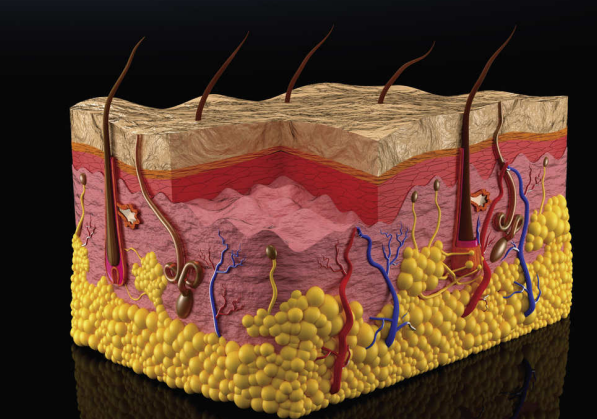
Introduction
The skin and its accessory structures (hair, nails, and glands) make up the integumentary system of the body. Integument means covering, and the skin (weighing 8 to 10 pounds and extending over an area of 22 square feet in an average adult) is the outer covering for the body. It is, however, more than a simple body covering. This complex system of specialized tissues contains glands that secrete several types of fluids, nerves that carry impulses, and blood vessels that aid in the regulation of the body temperature.
Da và các cấu trúc phụ (tóc, móng và tuyến) tạo thành hệ thống da như một phần của cơ thể. Integument có nghĩa là lớp bao phủ, và da (có trọng lượng từ 8 đến 10 pounds và bao phủ diện tích khoảng 22 feet vuông ở một người trưởng thành bình thường) là lớp bao ngoài của cơ thể. Tuy nhiên, da không chỉ đơn giản là một lớp bao bọc. Hệ thống phức tạp này của các mô chuyên biệt chứa các tuyến tiết ra nhiều loại chất lỏng, dây thần kinh mang các xung điện, và mạch máu giúp điều tiết nhiệt độ cơ thể.
The skin has many important functions:
Da có nhiều chức năng quan trọng:
First, as a protective membrane over the entire body, the skin guards the deeper tissues of the body against excessive loss of water, salts, and heat and against invasion of pathogens and their toxins. Specialized cells (Langerhans cells) react to the presence of antigens and have an immune function.
Thứ nhất, như một màng bảo vệ bao phủ toàn bộ cơ thể, da bảo vệ các mô sâu bên trong cơ thể chống lại việc mất nước, muối, và nhiệt quá mức cũng như chống lại sự xâm nhập của mầm bệnh và độc tố của chúng. Các tế bào chuyên biệt (tế bào Langerhans) phản ứng với sự hiện diện của kháng nguyên và có chức năng miễn dịch.
Second, the skin contains two types of glands that produce important secretions. These glands in the skin are the sebaceous glands and the sweat glands. Sebaceous glands produce sebum, an oily secretion, and sweat glands produce sweat, a watery secretion. Sebum and sweat pass to the outer edges of the skin through ducts and leave the skin through pores (openings). Sebum lubricates the surface of the skin, and sweat cools the body as it evaporates from the skin surface.
Thứ hai, da chứa hai loại tuyến sản xuất các chất tiết quan trọng. Những tuyến này trong da là tuyến bã nhờn và tuyến mồ hôi. Tuyến bã nhờn sản xuất bã nhờn, một chất tiết dầu, và tuyến mồ hôi sản xuất mồ hôi, một chất tiết dạng nước. Bã nhờn và mồ hôi đi đến bề mặt da thông qua các ống dẫn và thoát ra khỏi da qua các lỗ chân lông. Bã nhờn bôi trơn bề mặt da, và mồ hôi làm mát cơ thể khi bay hơi từ bề mặt da.
Third, nerve fibers under the skin are receptors for sensations such as pain, temperature, pressure, and touch. Thus, the body's adjustment to the environment depends on sensory messages relayed to the brain and spinal cord by sensitive nerve endings in the skin.
Thứ ba, các sợi thần kinh dưới da là các thụ thể cho các cảm giác như đau, nhiệt độ, áp lực, và xúc giác. Do đó, sự điều chỉnh của cơ thể với môi trường phụ thuộc vào các thông điệp cảm giác được truyền tới não và tủy sống bởi các đầu dây thần kinh nhạy cảm trong da.
Fourth, different tissues in the skin maintain body temperature (thermoregulation). Nerve fibers coordinate thermoregulation by carrying messages to the skin from heat centers in the brain that are sensitive to increases and decreases in body temperature. Impulses from these fibers cause blood vessels to dilate to bring blood to the surface and cause sweat glands to produce the watery secretion that carries heat away.
Thứ tư, các mô khác nhau trong da duy trì nhiệt độ cơ thể (điều tiết nhiệt). Các sợi thần kinh điều phối việc điều tiết nhiệt bằng cách truyền các thông điệp đến da từ các trung tâm nhiệt trong não, nhạy cảm với sự tăng và giảm nhiệt độ cơ thể. Các xung điện từ các sợi này làm các mạch máu giãn nở để đưa máu lên bề mặt và làm các tuyến mồ hôi sản xuất chất tiết dạng nước mang nhiệt ra ngoài.
Anatomy of the Skin (Giải phẫu của Da)
Figure 16-1A shows three layers of the skin. Label them from the outer surface inward:
Hình 16-1A cho thấy ba lớp của da. Ghi nhãn chúng từ bề mặt ngoài vào trong:
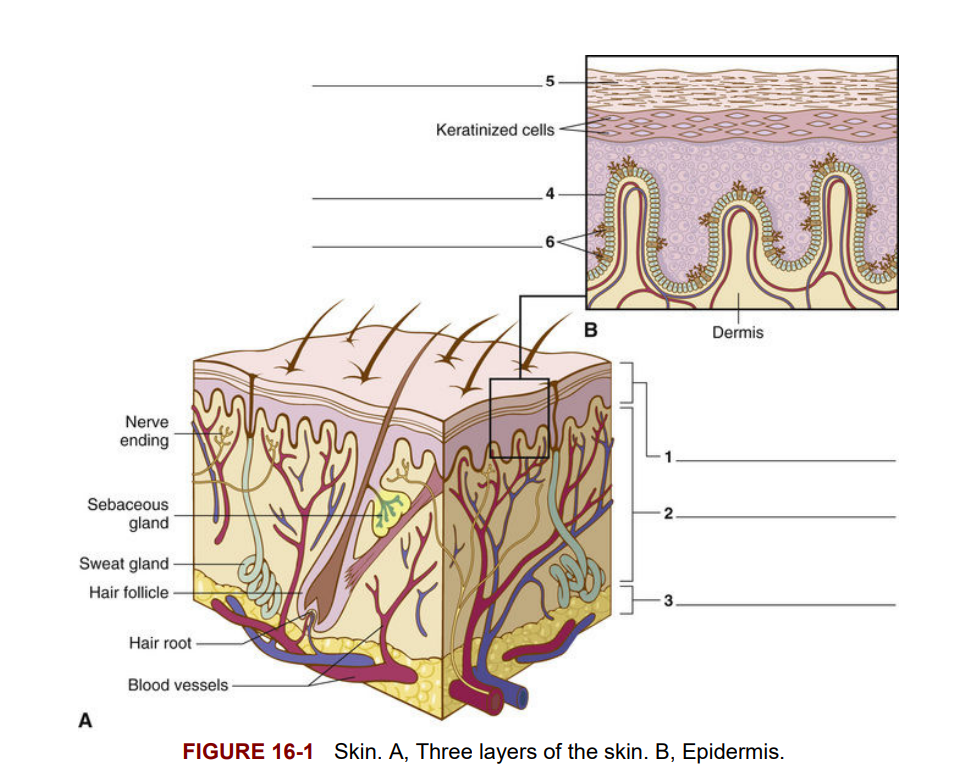 Epidermis [1]—a thin, cellular membrane layer; containing keratin
Epidermis [1]—a thin, cellular membrane layer; containing keratin
Biểu bì [1]—một lớp màng tế bào mỏng; chứa keratin
Dermis [2]—dense, fibrous, connective tissue layer; containing collagen
Hạ bì [2]—lớp mô liên kết dày đặc, có sợi; chứa collagen
Subcutaneous layer [3]—thick, fat-containing tissue
Lớp dưới da [3]—lớp mô chứa mỡ dày
Epidermis (Biểu bì)
The epidermis is the outermost totally cellular layer of the skin. It is composed of squamous epithelium. Epithelium is the covering of both the internal and the external surfaces of the body. Squamous epithelial cells are flat and scale-like. In the outer layer of the skin, these cells are arranged in several layers (strata) to form stratified squamous epithelium.
Biểu bì là lớp ngoài cùng hoàn toàn bao gồm các tế bào của da. Nó được cấu tạo bởi biểu mô vảy. Biểu mô là lớp bao phủ cả bề mặt bên trong và bên ngoài của cơ thể. Các tế bào biểu mô vảy có hình dẹt và giống như vảy. Trong lớp ngoài của da, các tế bào này được sắp xếp thành nhiều lớp (tầng) để tạo thành biểu mô vảy tầng.
The epidermis lacks blood vessels, lymphatic vessels, and connective tissue (elastic fibers, cartilage, fat) and is therefore dependent on the deeper dermis layer and its rich network of capillaries for nourishment. In fact, oxygen and nutrients seep out of the capillaries in the dermis, pass through tissue fluid, and supply nourishment to the lower layers of the epidermis.
Biểu bì không có mạch máu, mạch bạch huyết, và mô liên kết (sợi đàn hồi, sụn, mỡ) và do đó phụ thuộc vào lớp hạ bì sâu hơn và mạng lưới mao mạch phong phú của nó để cung cấp dưỡng chất. Thực tế, oxy và các chất dinh dưỡng thấm ra từ các mao mạch trong hạ bì, đi qua dịch mô và cung cấp dưỡng chất cho các lớp dưới của biểu bì.
Figure 16-1B illustrates the multilayered cells of the epidermis. The deepest layer is called the basal layer [4]. The cells in the basal layer are constantly growing and multiplying and are the source of all the other cells in the epidermis. As the basal layer cells divide, they are pushed upward and away from the blood supply of the dermal layer by a steady stream of younger cells. In their movement toward the most superficial layer of the epidermis, called the stratum corneum [5], the cells flatten, shrink, lose their nuclei, and die, becoming filled with a hard protein material called keratin. The cells are then called keratinocytes, reflecting their composition of keratin. Finally, within 3 to 4 weeks after beginning as a basal cell in the deepest part of the epidermis, the keratinized cell is sloughed off from the surface of the skin. The epidermis is thus constantly renewing itself, with cells dying at the same rate at which they are replaced. This process slows with age.
Hình 16-1B minh họa các tế bào nhiều lớp của biểu bì. Lớp sâu nhất được gọi là lớp đáy [4]. Các tế bào trong lớp đáy liên tục phát triển và nhân lên và là nguồn gốc của tất cả các tế bào khác trong biểu bì. Khi các tế bào lớp đáy phân chia, chúng bị đẩy lên phía trên và ra khỏi nguồn cung cấp máu của lớp hạ bì bởi một dòng tế bào trẻ liên tục. Trong quá trình di chuyển về phía lớp ngoài cùng của biểu bì, được gọi là lớp sừng [5], các tế bào dẹt lại, co lại, mất nhân và chết, trở thành đầy đủ chất đạm cứng gọi là keratin. Sau đó, các tế bào này được gọi là keratinocytes, phản ánh thành phần keratin của chúng. Cuối cùng, trong vòng 3 đến 4 tuần sau khi bắt đầu là một tế bào đáy ở phần sâu nhất của biểu bì, tế bào đã keratin hóa sẽ bị loại bỏ khỏi bề mặt da. Do đó, biểu bì liên tục tự làm mới, với các tế bào chết với tốc độ mà chúng được thay thế. Quá trình này chậm lại theo tuổi tác.
The basal layer of the epidermis contains special cells called melanocytes [6]. Melanocytes contain a pigment called melanin that is transferred to other epidermal cells and gives color to the skin. The number of melanocytes in all human races is the same, but the amount of melanin within each cell accounts for the color differences among the races. Individuals with darker skin possess more melanin within the melanocytes, not a greater number of melanocytes. Individuals who are incapable of forming melanin have a condition called albinism. Skin and hair are white. In albinism, eye color varies, ranging from red to blue to brown, depending on the amount of melanin present in the iris (pigmented portion of the eye). Occulocutaneous albinism affects eyes, skin, and hair, whereas ocular albinism affects the eyes only.
Lớp đáy của biểu bì chứa các tế bào đặc biệt được gọi là tế bào hắc tố (melanocytes) [6]. Tế bào hắc tố chứa một sắc tố gọi là melanin, được chuyển đến các tế bào biểu bì khác và mang lại màu sắc cho da. Số lượng tế bào hắc tố ở tất cả các chủng tộc là như nhau, nhưng lượng melanin trong mỗi tế bào giải thích sự khác biệt về màu da giữa các chủng tộc. Những người có làn da sẫm màu hơn có nhiều melanin hơn trong các tế bào hắc tố, chứ không phải là số lượng tế bào hắc tố nhiều hơn. Những người không thể tạo ra melanin có một tình trạng gọi là bạch tạng. Da và tóc của họ có màu trắng. Trong bạch tạng, màu mắt thay đổi, từ đỏ đến xanh lam đến nâu, tùy thuộc vào lượng melanin có trong mống mắt (phần có sắc tố của mắt). Bạch tạng da và mắt (oculocutaneous albinism) ảnh hưởng đến mắt, da và tóc, trong khi bạch tạng mắt (ocular albinism) chỉ ảnh hưởng đến mắt.
Types of Melanin
Eumelanin and Pheomelanin
Eumelanin (eu- = true) is more common and is a brown-black pigment. Pheomelanin (pheo- = dusky) is a red-yellow pigment. People with darker skin have more eumelanin, whereas people with lighter skin have more pheomelanin. Pheomelanin doesn't protect the skin from damaging ultraviolet rays and makes lighter-skinned people, and especially redheads, more susceptible to skin cancer.
Các loại Melanin
Eumelanin và Pheomelanin
Eumelanin (eu- = thật) là loại phổ biến hơn và là một sắc tố màu nâu-đen. Pheomelanin (pheo- = tối) là một sắc tố màu đỏ-vàng. Những người có làn da sẫm màu có nhiều eumelanin hơn, trong khi những người có làn da sáng hơn có nhiều pheomelanin hơn. Pheomelanin không bảo vệ da khỏi các tia cực tím có hại và làm cho những người có làn da sáng hơn, đặc biệt là những người tóc đỏ, dễ bị ung thư da hơn.
Melanin production increases with exposure to strong ultraviolet light, and this creates a suntan, which is a protective response. When the melanin cannot absorb all of the ultraviolet rays, the skin becomes sunburned and inflamed (redness, swelling, and pain). Over a period of years, excessive exposure to sun tends to cause wrinkles, permanent pigmentary changes, and even cancer of the skin. Because dark-skinned people have more melanin, they acquire fewer wrinkles and they are less likely to develop the types of skin cancer that are associated with ultraviolet light exposure.
Sản xuất melanin tăng lên khi tiếp xúc với ánh sáng cực tím mạnh, và điều này tạo ra một làn da rám nắng, đây là một phản ứng bảo vệ. Khi melanin không thể hấp thụ hết các tia cực tím, da trở nên bị cháy nắng và viêm nổi (sưng đỏ, phồng, và đau đớn). Trong suốt một khoảng thời gian nhiều năm, tiếp xúc quá mức với ánh sáng mặt trời có xu hướng gây nếp nhăn, thay đổi màu da vĩnh viễn và thậm chí ung thư da. Do người có làn da sẫm màu có nhiều melanin hơn, họ ít bị nhăn và ít có khả năng phát triển các loại ung thư da liên quan đến tiếp xúc với ánh sáng cực tím.
Dermis
The dermis, directly below the epidermis, is composed of blood vessels and lymph and nerve fibers, as well as the accessory organs of the skin, which are the hair follicles, sweat glands, and sebaceous glands. To support the elaborate system of nerves, vessels, and glands, the dermis contains connective tissue cells and fibers that account for the extensibility and elasticity of the skin.
The dermis is composed of interwoven elastin (protein that is elastic and helps skin to return to its original position when pinched or poked) and collagen fibers. Collagen (colla = glue) is a fibrous protein material found in bone, cartilage, tendons, and ligaments, as well as in the skin. It is tough and resistant but also flexible. In the infant, collagen is loose and delicate; it becomes harder as the body ages. During pregnancy, overstretching of the skin with weight gain may break the elastin fibers, resulting in linear markings called striae (“stretch marks”) on the woman's abdomen and elsewhere. Collagen fibers support and protect the blood and nerve networks that pass through the dermis. Collagen diseases affect connective tissues of the body. An example of a connective tissue collagen disorder is scleroderma.
Hạ bì
Hạ bì, ngay dưới biểu bì, bao gồm các mạch máu, mạch bạch huyết, các sợi thần kinh và các cơ quan phụ của da, bao gồm nang lông, tuyến mồ hôi và tuyến bã nhờn. Để hỗ trợ hệ thống phức tạp của thần kinh, mạch máu và tuyến, hạ bì chứa các tế bào và sợi mô liên kết giải thích sự có thể kéo dãn và đàn hồi của da. Hạ bì được cấu thành từ các sợi elastin (một loại protein co giãn giúp da trở về vị trí ban đầu sau khi bị bóp hoặc xỏ) và các sợi collagen. Collagen (colla = keo) là một loại protein sợi được tìm thấy trong xương, sụn, gân và dây chằng, cũng như trong da. Nó chắc chắn và chịu được nhưng cũng có tính linh hoạt. Ở trẻ sơ sinh, collagen mềm và tinh tế; nó trở nên cứng hơn khi cơ thể lão hóa. Trong thời kỳ mang thai, khi da bị căng bằng sự tăng cân, các sợi elastin có thể bị vỡ, dẫn đến các vết rạn trên bụng và nơi khác được gọi là đường rạn ("stretch marks"). Các sợi collagen hỗ trợ và bảo vệ các mạng lưới mạch máu và thần kinh đi qua hạ bì. Các bệnh collagen ảnh hưởng đến các mô liên kết của cơ thể. Một ví dụ về một rối loạn collagen mô liên kết là bệnh cơ liên kết (scleroderma).
Subcutaneous Layer (Lớp dưới da)
The subcutaneous layer (epidermis and dermis are the cutaneous layers) specializes in the formation of fat. Adipocytes (fat cells) are predominant in the subcutaneous layer, and they manufacture and store large quantities of fat. Fat deposition varies in different areas of the body and among individual people. Functionally, this layer of the skin is important in protection of the deeper tissues of the body, as a heat insulator, and for energy storage.
Lớp dưới da (biểu bì và hạ bì là các lớp da) chuyên biệt trong việc hình thành mỡ. Các tế bào mỡ (adipocytes) là chủ yếu trong lớp dưới da, và chúng sản xuất và lưu trữ một lượng lớn mỡ. Sự tích tụ mỡ khác nhau ở các vùng khác nhau của cơ thể và giữa các cá nhân. Chức năng của lớp này của da rất quan trọng trong việc bảo vệ các mô sâu bên trong cơ thể, như một lớp cách nhiệt và để lưu trữ năng lượng.
Accessory Structures of the Skin (Các Cấu Trúc Phụ Thuộc của Da)
Hair (Tóc)
A hair fiber is composed of a tightly fused meshwork of cells filled with the hard protein called keratin. Hair growth is similar to the growth of the epidermal layer of the skin. Deep-lying cells in the hair root (Figure 16-2) produce keratinized cells that move upward through hair follicles (sacs within which each hair fiber grows). Melanocytes (see Figure 16-2) are located at the root of the hair follicle, and they donate the melanin pigment to the cells of the hair fiber.
Một sợi tóc bao gồm một mạng lưới chặt chẽ của các tế bào được hàn lại với nhau, được điền vào protein cứng gọi là keratin. Sự phát triển tóc tương tự như sự phát triển của lớp biểu bì của da. Các tế bào sâu trong gốc tóc (Xem Hình 16-2) sản xuất các tế bào đã keratin hóa di chuyển lên qua nang lông (các túi trong đó mỗi sợi tóc phát triển). Tế bào hắc tố (xem Hình 16-2) nằm ở gốc nang lông, và chúng cung cấp sắc tố melanin cho các tế bào của sợi tóc.
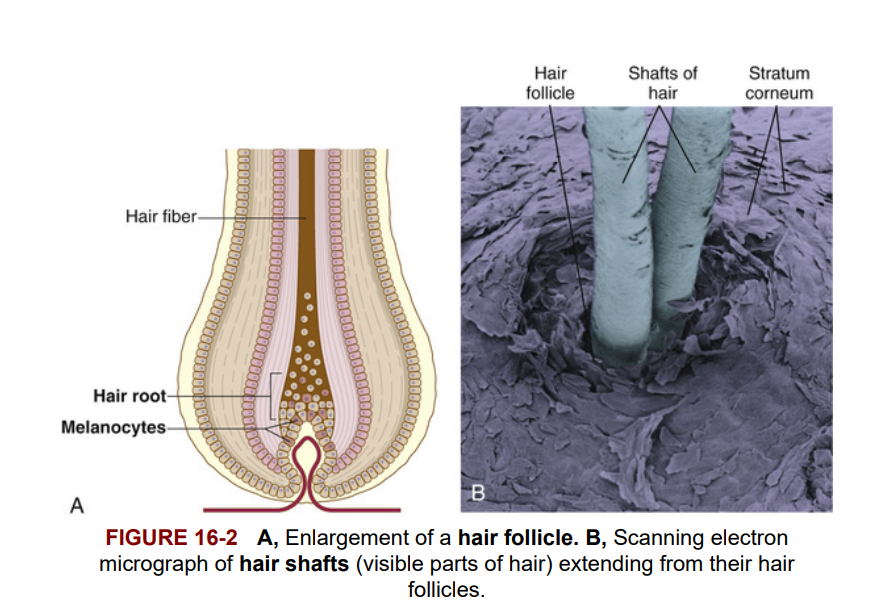 Of the 5 million hairs on the body, about 100,000 are on the head. They grow about 1/2 inch (1.3 cm) per month. Cutting the hair has no effect on its rate of growth.
Of the 5 million hairs on the body, about 100,000 are on the head. They grow about 1/2 inch (1.3 cm) per month. Cutting the hair has no effect on its rate of growth.
Trong số 5 triệu sợi tóc trên cơ thể, khoảng 100.000 sợi nằm trên đầu. Tóc mọc khoảng 1/2 inch (1,3 cm) mỗi tháng. Việc cắt tóc không ảnh hưởng đến tốc độ mọc của nó.
What causes hair color?
Concentration of eumelanin and pheomelanin cause the variations in hair color. For example:
• Black hair = high levels of black eumelanin
• Brown hair = high levels of brown eumelanin
• Blond hair = low levels of black eumelanin
• Red hair = high levels of pheomelanin
• Gray hair = low concentration of eumelanin and pheomelanin
Nguyên nhân gây ra màu tóc
Nồng độ của eumelanin và pheomelanin gây ra các biến thể trong màu tóc. Ví dụ:
Tóc đen = nồng độ cao của eumelanin đen
Tóc nâu = nồng độ cao của eumelanin nâu
Tóc vàng = nồng độ thấp của eumelanin đen
Tóc đỏ = nồng độ cao của pheomelanin
Tóc xám = nồng độ thấp của eumelanin và pheomelanin
Nails (Móng)
Nails are hard keratin plates covering the dorsal surface of the last bone of each toe and finger. They are composed of keratinocytes that are cemented together tightly and can extend indefinitely unless cut or broken. A nail grows in thickness and length as a result of division of cells in the region of the nail matrix, which is at the base (proximal portion) of the nail plate.
Móng là các tấm keratin cứng bao phủ bề mặt lưng của xương cuối cùng của mỗi ngón chân và ngón tay. Chúng được cấu tạo bởi các tế bào keratinocyte được gắn kết chặt chẽ với nhau và có thể kéo dài vô hạn nếu không bị cắt hoặc gãy. Móng phát triển về độ dày và chiều dài do sự phân chia của các tế bào trong vùng ma trận móng, nằm ở gốc (phần gần) của tấm móng.
Fingernails grow about 1 mm per week, which means that they can regrow in 3 to 5 months. Toenails grow more slowly than fingernails; it takes approximately 12 months for toenails to be replaced completely.
Móng tay mọc khoảng 1 mm mỗi tuần, nghĩa là chúng có thể mọc lại trong vòng 3 đến 5 tháng. Móng chân mọc chậm hơn so với móng tay; mất khoảng 12 tháng để móng chân được thay thế hoàn toàn.
The lunula is a semilunar (half-moon–shaped) whitish region at the base of the nail plate. It generally can be seen in the thumbnail of most people and is evident to varying degrees in other fingernails. Air mixed in with keratin and cells rich in nuclei give the lunula its whitish color. The cuticle, a narrow band of epidermis (layer of keratin), is at the base and sides of the nail plate. The paronychium is the soft tissue surrounding the nail border. Figure 16-3A illustrates the anatomic structure of a nail.
Lunula là một vùng màu trắng hình bán nguyệt (hình nửa mặt trăng) ở gốc tấm móng. Nó thường có thể được nhìn thấy rõ ràng ở móng tay cái của hầu hết mọi người và hiện rõ ở các mức độ khác nhau trong các móng tay khác. Không khí trộn lẫn với keratin và các tế bào giàu nhân làm cho lunula có màu trắng. Cuticle là một dải hẹp của biểu bì (lớp keratin) nằm ở gốc và hai bên của tấm móng. Paronychium là mô mềm bao quanh viền móng. Hình 16-3A minh họa cấu trúc giải phẫu của một chiếc móng.
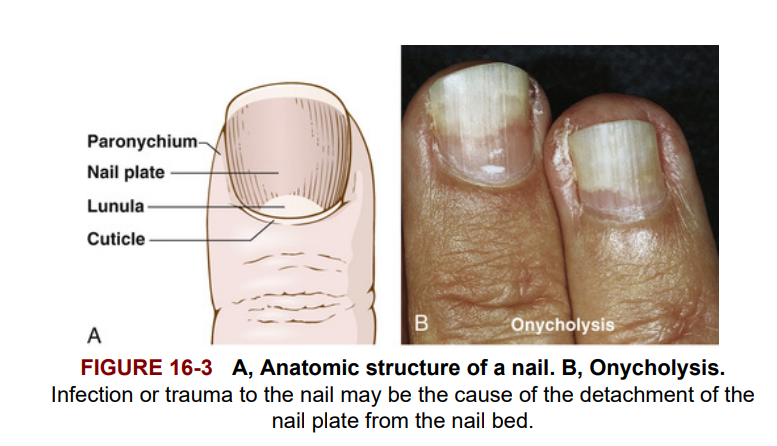 Nail growth and appearance commonly alter during systemic disease. For example, grooves in nails may occur with high fevers and serious illness, and spoon nails (flattening of the nail plate) develop in iron deficiency anemia. Onycholysis (onych/o = nail) is the loosening of the nail plate with separation from the nail bed (Figure 16-3B). It may occur with infection of the nail and is often seen in psoriasis.
Nail growth and appearance commonly alter during systemic disease. For example, grooves in nails may occur with high fevers and serious illness, and spoon nails (flattening of the nail plate) develop in iron deficiency anemia. Onycholysis (onych/o = nail) is the loosening of the nail plate with separation from the nail bed (Figure 16-3B). It may occur with infection of the nail and is often seen in psoriasis.
Sự phát triển và hình dạng của móng thường thay đổi trong các bệnh hệ thống. Ví dụ, các rãnh trên móng có thể xuất hiện khi sốt cao và bệnh nghiêm trọng, và móng hình thìa (làm phẳng tấm móng) phát triển trong tình trạng thiếu máu do thiếu sắt. Onycholysis (onych/o = móng) là sự lỏng lẻo của tấm móng với sự tách rời khỏi giường móng (Xem Hình 16-3B). Nó có thể xảy ra khi nhiễm trùng móng và thường được thấy trong bệnh vẩy nến.
Glands (Tuyến)
Sebaceous Glands (Tuyến bã nhờn)
Sebaceous glands are located in the dermal layer of the skin over the entire body, with the exception of the palms (hands), soles (feet), and lips. They secrete an oily substance called sebum. Sebum, containing lipids, lubricates the skin and minimizes water loss. Sebaceous glands are closely associated with hair follicles, and their ducts open into the hair follicle through which the sebum is released. Figure 16-4 shows the relationship of the sebaceous gland to the hair follicle. The sebaceous glands are influenced by sex hormones, which cause them to hypertrophy at puberty and atrophy in old age. Increased production of sebum during puberty contributes to blackhead (comedo) formation and acne in some people.
Tuyến bã nhờn nằm ở lớp hạ bì của da trên khắp cơ thể, ngoại trừ lòng bàn tay (tay), lòng bàn chân (chân) và môi. Chúng tiết ra một chất nhờn gọi là bã nhờn. Bã nhờn, chứa lipid, bôi trơn da và giảm thiểu mất nước. Tuyến bã nhờn liên kết chặt chẽ với nang lông, và các ống dẫn của chúng mở ra vào nang lông qua đó bã nhờn được giải phóng. Hình 16-4 cho thấy mối quan hệ giữa tuyến bã nhờn và nang lông. Tuyến bã nhờn bị ảnh hưởng bởi hormone sinh dục, làm chúng phì đại ở tuổi dậy thì và teo lại ở tuổi già. Sản xuất bã nhờn tăng trong tuổi dậy thì góp phần vào việc hình thành mụn đầu đen (comedo) và mụn trứng cá ở một số người.
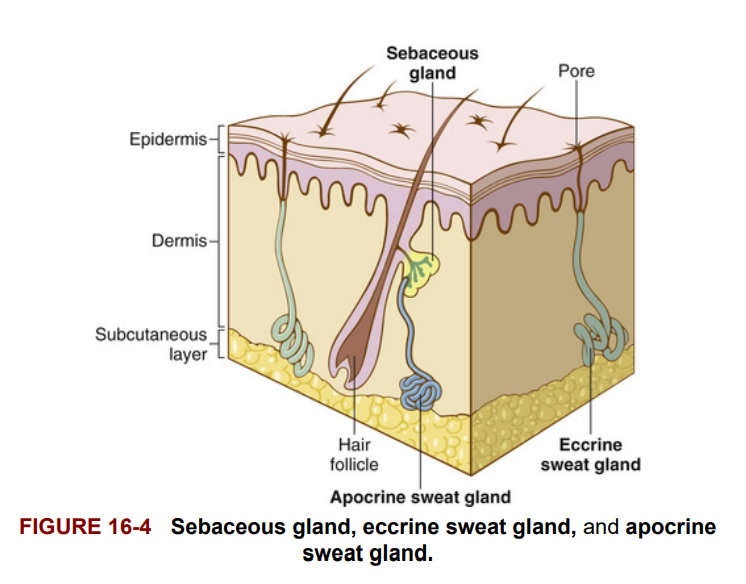 Sweat Glands (Tuyến mồ hôi)
Sweat Glands (Tuyến mồ hôi)
Sweat glands (the most common type are eccrine sweat glands) are tiny, coiled glands found on almost all body surfaces (about 2 million in the body). They are most numerous in the palm of the hand (3000 glands per square inch) and in the sole of the foot. As illustrated in Figure 16-4, the coiled eccrine sweat gland originates deep in the dermis and straightens out to extend up through the epidermis. The tiny opening on the surface is a pore.
Tuyến mồ hôi (loại phổ biến nhất là tuyến mồ hôi eccrine) là các tuyến nhỏ, cuộn tròn được tìm thấy trên hầu hết các bề mặt cơ thể (khoảng 2 triệu trên cơ thể). Chúng nhiều nhất ở lòng bàn tay (3000 tuyến trên mỗi inch vuông) và lòng bàn chân. Như minh họa trong Hình 16-4, tuyến mồ hôi eccrine cuộn tròn bắt nguồn từ sâu trong hạ bì và duỗi thẳng ra để kéo dài lên qua biểu bì. Lỗ nhỏ trên bề mặt được gọi là lỗ chân lông.
Sweat, or perspiration, is almost pure water, with dissolved materials such as salt making up less than 1% of the total composition. It is colorless and odorless. The odor produced when sweat accumulates on the skin is caused by the action of bacteria on the sweat.
Mồ hôi, hay còn gọi là sự thoát mồ hôi, hầu như là nước tinh khiết, với các chất hòa tan như muối chiếm ít hơn 1% tổng thành phần. Nó không có màu và không có mùi. Mùi được tạo ra khi mồ hôi tích tụ trên da là do vi khuẩn tác động lên mồ hôi.
Sweat cools the body as it evaporates into the air. Perspiration is controlled by the sympathetic nervous system, whose nerve fibers are activated by the heart regulatory center in the hypothalamic region of the brain, which stimulates sweating.
Mồ hôi làm mát cơ thể khi bay hơi vào không khí. Sự thoát mồ hôi được kiểm soát bởi hệ thần kinh giao cảm, các sợi thần kinh của nó được kích hoạt bởi trung tâm điều tiết nhiệt ở vùng dưới đồi của não, nơi kích thích việc đổ mồ hôi.
A special variety of sweat gland, active only from puberty onward and larger than the ordinary kind, is concentrated in a few areas of the body near the reproductive organs and in the armpits. These glands (apocrine sweat glands) secrete an odorless sweat, containing substances easily broken down by bacteria on the skin. The bacterial waste products produce a characteristic human body odor. The milk-producing mammary gland is another type of apocrine gland; it secretes milk after the birth of a child.
Một loại đặc biệt của tuyến mồ hôi, hoạt động chỉ từ tuổi dậy thì trở đi và lớn hơn loại thông thường, tập trung ở một vài khu vực của cơ thể gần các cơ quan sinh dục và ở nách. Những tuyến này (tuyến mồ hôi apocrine) tiết ra mồ hôi không mùi, chứa các chất dễ bị phân hủy bởi vi khuẩn trên da. Các sản phẩm chất thải của vi khuẩn tạo ra mùi hôi đặc trưng của cơ thể con người. Tuyến vú sản sinh sữa cũng là một loại tuyến apocrine; nó tiết ra sữa sau khi sinh con.
adipocyte
Fat cell.
albinism
Condition of skin deficient in pigment (melanin).
apocrine sweat gland
One of the large dermal exocrine glands located in the axilla and genital areas. It secretes sweat that, in action with bacteria, is responsible for human body odor.
basal layer
Deepest region of the epidermis; it gives rise to all the epidermal cells.
collagen
Structural protein found in the skin and connective tissue.
cuticle
Band of epidermis at the base and sides of the nail plate.
dermis
Middle layer of the skin. eccrine sweat gland Most numerous sweat-producing exocrine gland in the skin.
epidermis
Outermost layer of the skin.
epithelium
Layer of skin cells forming the outer and inner surfaces of the body.
hair follicle
Sac within which each hair grows.
integumentary system
The skin and its accessory structures such as hair and nails.
keratin
Hard protein material found in the epidermis, hair, and nails. Keratin means horn and commonly is found in the horns of animals.
lunula
Half-moon–shaped, whitish area at the base of a nail.
melanin
Skin pigment. It is formed by melanocytes in the epidermis. Eumelanin is brown-black pigment, whereas pheomelanin is red-yellow.
paronychium
Soft tissue surrounding the nail border.
pore
Tiny opening on the surface of the skin.
sebaceous gland
Oil-secreting gland in the dermis that is associated with hair follicles.
sebum
Oily substance secreted by sebaceous glands.
squamous epithelium
Flat, scale-like cells composing the epidermis. stratified Arranged in layers.
stratum (plural: strata)
A layer (of cells).
stratum corneum
Outermost layer of the epidermis, which consists of flattened, keratinized cells.
subcutaneous layer
Innermost layer of the skin, containing fat tissue.